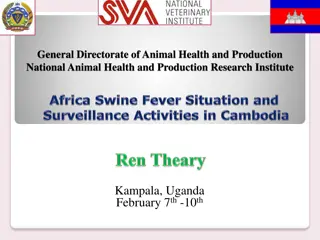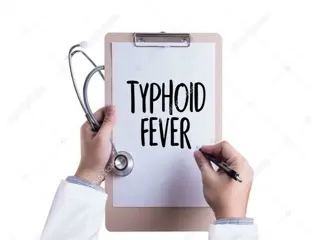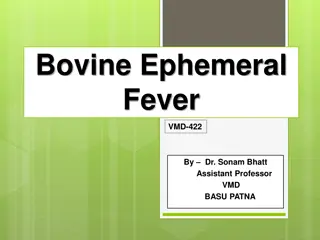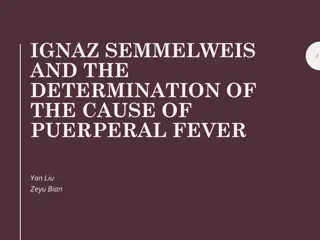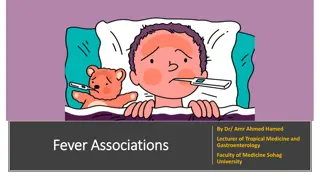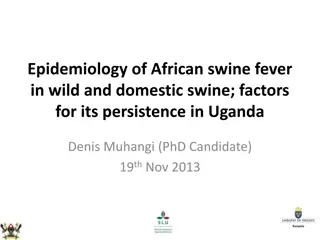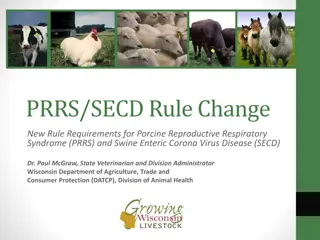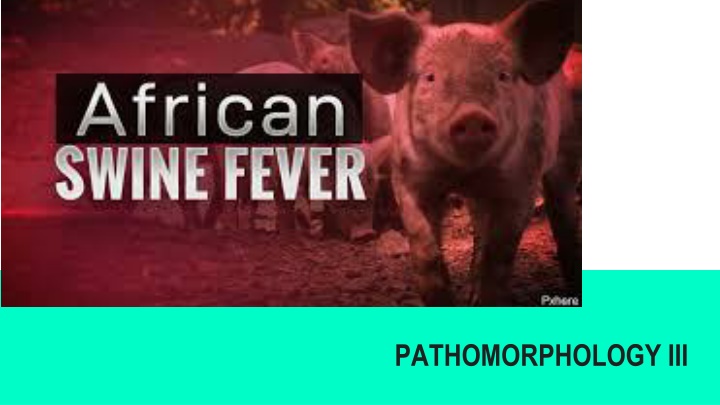
African Swine Fever: Causes, Symptoms, and Management
African Swine Fever is a highly contagious hemorrhagic disease affecting domestic and wild pigs, leading to significant economic losses. Caused by a DNA virus, it is distinct from classical swine fever and has a resilient nature against various physical and chemical actions. The disease progresses through stages of pathogenesis, resulting in a range of clinical signs with varying mortality rates. Effective prevention and control measures are crucial to managing the impact of African Swine Fever on pig populations.
Download Presentation

Please find below an Image/Link to download the presentation.
The content on the website is provided AS IS for your information and personal use only. It may not be sold, licensed, or shared on other websites without obtaining consent from the author. If you encounter any issues during the download, it is possible that the publisher has removed the file from their server.
You are allowed to download the files provided on this website for personal or commercial use, subject to the condition that they are used lawfully. All files are the property of their respective owners.
The content on the website is provided AS IS for your information and personal use only. It may not be sold, licensed, or shared on other websites without obtaining consent from the author.
E N D
Presentation Transcript
INTRODUCTION Is a highly contagious hemorrhagic disease that affects domestic and wild pigs, causing serious economic and productive losses. It is caused by a DNA virus of the Asfarviridae family, which also infects ticks of the genus Ornithodoros. While the signs of African swine fever and those of classical swine fever may be similar, there is no relationship between the viruses. AFS is a disease referred to in the Terrestrial Animal Health Code of the World Organization for Animal Health (OIE), mandatory declaration. Is present in domestic and wild pigs in regions of Asia, Europe and Africa.
ETIOLOGY Causal Agent Classification Caused by a double-stranded DNA virus with envelope and icosahedral symmetry, unique member of the Asfarviridae family, genus Asfivirus, from which they differ genotypes. Different strains of African swine fever virus present differences in their virulence.
Resistance to physical and chemical action - Temperature: Very resistant to low temperatures. Heat inactivated at 56 C/70 min; 60 C/20 min. pH: Inactivated at pH <3.9 or >11.5 in a serum-free medium. The serum increases the resistance of the virus. - - Chemicals: Sensitive to ether and chloroform. - Disinfectants: Inactivated by 8/1,000 sodium hydroxide (30 min), hypochlorites - 2.3% chlorine (30 min), 3/1,000 formalin (30 min), 3% orthophenylphenol (30 min) and iodine compounds. - Survival: It remains viable for a long time in the blood, feces and tissues. It can be multiplied in vectors of the genus Ornithodoros or by oronasal route.
PATHOGENESIS After infection, there is a multiplication in lymphoreticular organs, producing a viremia that will cause death or will be oscillating in the event that it recovers. It is eliminated by different routes and will cause lesions in lymphoreticular tissue, serious vascular lesions and frequently secondary infections.
Clinical signs The mortality rate and clinical signs may vary depending on the virulence of the virus and the type/species of pig. African wild pigs can be infected without showing any clinical signs, which transforms them into reservoirs. Acute form: high fever, depression, anorexia and loss of appetite, bleeding (redness of the skin of the ears, abdomen and legs), abortions in pregnant sows, cyanosis, vomiting, diarrhea and death after 6-13 days (or up to 20 days). The mortality rate can reach 100%. Subacute and chronic forms: are caused by moderate or less virulent viruses, which produce less intense clinical signs that may manifest themselves over longer periods. Mortality rates are lower, but can range between 30 and 70%. Symptoms of chronic disease include weight loss, intermittent fever, respiratory problems, chronic skin ulcerations and arthritis.
DIAGNOSIS Identification of the agent a) Haemadsorption test (HAD) in primary leukocyte cultures b) Antigen detection by fluorescent antibody test (FAT) c) Detection of virus genome by the polymerase chain reaction PCR Serological tests a) Enzyme-linked immunosorbent assay b) Indirect fluorescent antibody (IFA) test should be used as a confirmatory test for sera from areas that are free from ASF and are positive in the ELISA c) Immunoblotting test or immunoperoxidase staining used as an alternative to the IFA test to confirm equivocal results with individual sera
NECROPSY AND HISTOPATHOLOGICAL CHANCE Hemorrhage of the gastrohepatic lymph node (arrow and right picture), is a very characteristic lesion. The gallbladder shows areas of bleeding in its wall. In the digestive tract petechiae can be seen in the serosa, as is the case of the stomach (asterisk).
In more severe cases, perirenal edema is observed, in the image we have removed the peritoneum. The kidneys have multiple petechial hemorrhages. Renal lymph nodes also tend to bleed.
Epicardial hemorrhages Petechial hemorrhages (<3mm in diameter) of miliary distribution in the cortex and renal pelvis. Pulmonary edema, evidenced by the lack of collapse of the lungs with evident interstitial edema between pulmonary lobules. (no especific)
Marked pulmonary edema, evidenced by the presence of foam inside the trachea (open longitudinally). Marked increase in spleen size (splenomegaly). (No especific)
Edema of the bladder wall.
TREATMENT There is no authorized vaccine against African swine fever. Prevention in disease-free countries depends on the adoption of appropriate import policies and biosafety measures, which prevent the introduction of live pigs and infected pig products in areas free of African swine fever. During outbreaks and in affected countries, control of African swine fever can be difficult and should be adapted to the specific epidemiological situation. Classic sanitary measures can be used, including early detection and humanitarian killing of animals (with the corresponding elimination of canals and wastes); cleaning and disinfection; zoning / compartmentalization and movement control; surveillance and detailed epidemiological research and strict biosecurity measures on farms.
In Europe and in regions of Asia, the transmission of African swine fever seems to depend largely on the population density of wild boars and their interaction with pig production systems with low levels of biosafety. The knowledge and good management of the wild boar population, and good coordination between the Veterinary Services and wildlife and forestry authorities are necessary to prevent and control African swine fever successfully. Depending on the epidemiological situation, in the control programs, the participation of the soft tick as a vector should also be considered.

